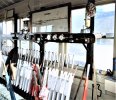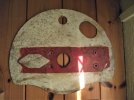I've looked at a few signal box track diagrams and I find them very interesting.
I'm unclear though about several things about them, one box on my old line had 20 levers but was only using 7 at the time of closure in 1964. It was built by the L&Y in 1888 just prior to the building of the carriage shed at Great Harwood.
This box was only opened for movements in / out of the carriage shed and its siding. Due to lack of space around there, this layout really didn't change over the years.
So why have a box with so many spare levers? I understand that removing a set of points would make one lever spare, but why so many spare when you have no space to add extra track etc?
Were these boxes (levers and interlocking frames) supplied with spare capacity? or were they modular, that is built with 10, 15, 20 levers etc? or built specifically for a certain layout / location?
Thanks,
Andy.
I'm unclear though about several things about them, one box on my old line had 20 levers but was only using 7 at the time of closure in 1964. It was built by the L&Y in 1888 just prior to the building of the carriage shed at Great Harwood.
This box was only opened for movements in / out of the carriage shed and its siding. Due to lack of space around there, this layout really didn't change over the years.
So why have a box with so many spare levers? I understand that removing a set of points would make one lever spare, but why so many spare when you have no space to add extra track etc?
Were these boxes (levers and interlocking frames) supplied with spare capacity? or were they modular, that is built with 10, 15, 20 levers etc? or built specifically for a certain layout / location?
Thanks,
Andy.



